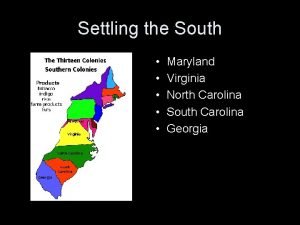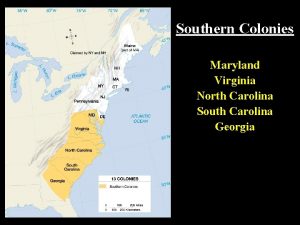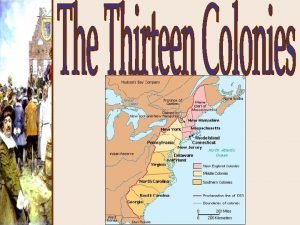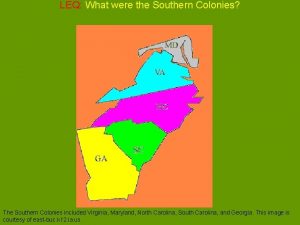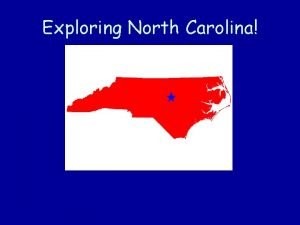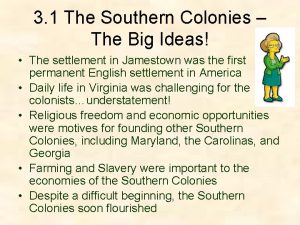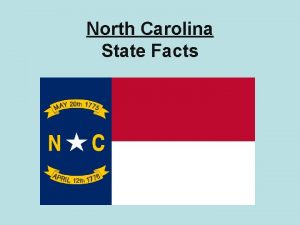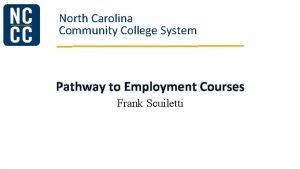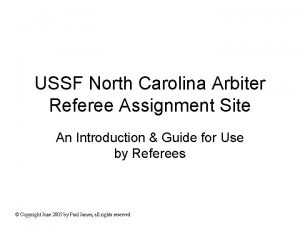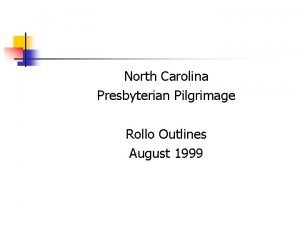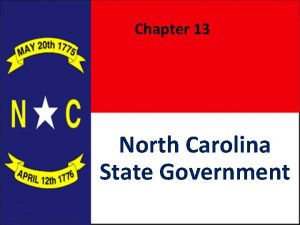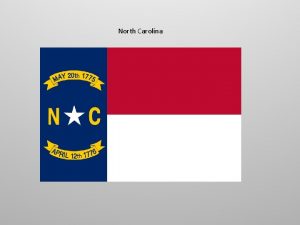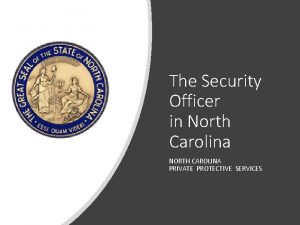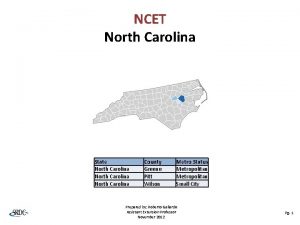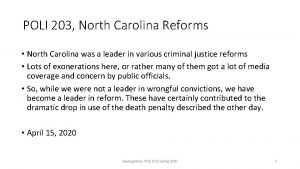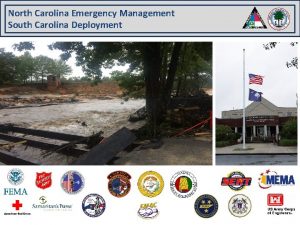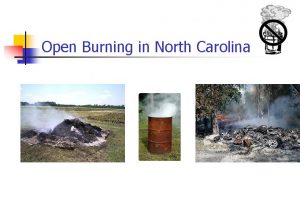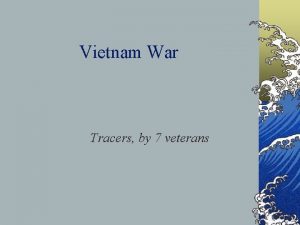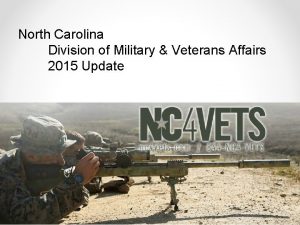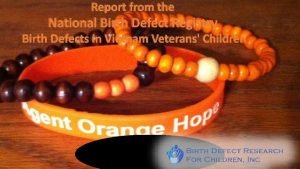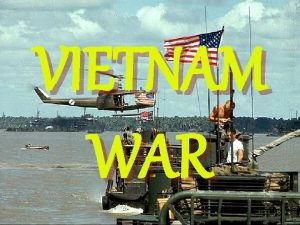North Carolina Vietnam Veterans Inc Lessons of Vietnam


























- Slides: 26

North Carolina Vietnam Veterans, Inc. Lessons of Vietnam POW/MIA’S Their stories and families stories

North Carolina Vietnam Veterans, Inc. The POW story facts and mis-facts • When our imprisoned comrades returned from South East Asia in 1973, it was evident that not all of our known missing were returned. There have been many facts and miss-facts disseminated to the public and to the POW/MIA families since that time. Which are truths and which are lies, we may never know. • What we do know is that since World War l, in any conflict involving the Communist, not all of our missing comrades in arms have been returned or accounted for. After WWll-73, 600 +MIAs were unaccounted for; after the Korean War-7, 900+ MIAs were unaccounted for. 121 of these unaccounted for are North Carolinians; after the war in Vietnam, there was 1, 640+ of our brothers unaccounted for and of this number there are 41 from North Carolina still unaccounted for.

History of the POW/MIA Flag In 1970, Mrs. Michael Hoff, an MIA wife and member of the National League of Families, recognized the need for a symbol of our POW/MIAs. Prompted by an article in the Jacksonville, Florida, Times-Union, Mrs. Hoff contacted Norman Rivkees, Vice President of Annin & Company, which had made a banner for the newest member of the United Nations, the People’s Republic of China (PRC), as part of their policy to manufacture flags for all United Nations member states. Mr. Rivkees and Newt Hensley designed a flag to represent our missing. Wanting the widest possible dissemination and use of the symbol to advocate improved treatment for and answers on American POW/MIAs, no trade mark or copyright was sought.

POW Bracelets • The National League of POW/MIA Families • History of the POW/MIA Bracelets • Over the years, people have contacted the League looking for information on the history and background of the POW/MIA bracelets, originated and worn extensively in the 1970 s, and continuously since by POW/MIA family members, veterans and other interested Americans. The following historical information was written by Carol Bates Brown, one of the originators: I was the National Chairman of the POW/MIA Bracelet Campaign for VIVA (Voices In Vital America), the Los Angeles based student organization that produced and distributed the bracelets during the Vietnam War. Entertainers Bob Hope and Martha Raye served with me as honorary co-chairmen. The idea for the bracelets was started by a fellow college student, Kay Hunter, and me, as a way to remember American prisoners of war suffering in captivity in Southeast Asia. In late 1969, television personality Bob Dornan introduced us and several other members of VIVA to three wives of missing pilots. They thought our student group could assist them in drawing public attention to the prisoners and missing in Vietnam. The idea of circulating petitions and letters to Hanoi demanding humane treatment for the POWs was appealing, as we were looking for ways college students could become involved in positive programs to support US soldiers without becoming embroiled in the controversy of the war itself. The relatives of the men were beginning to organize locally, but the National League of POW/MIA Families had yet to be formed. During that time, Bob Dornan wore a bracelet he had obtained in Vietnam from hill tribesmen, which he said always reminded him of the suffering the war had brought to so many.

Operation Homecoming Newly freed prisoners of war celebrate as their C-141 A aircraft lifts off from Hanoi, North Vietnam, on Feb. 12, 1973, during Operation Homecoming. The mission included 54 C-141 flights between Feb. 12 and April 4, 1973, returning 591 POWs to American soil. U. S. Air Force photo . Operation Homecoming for Vietnam POWs By Donna Miles………American Forces Press Service, A C-141 A Starlifter transport jet with a distinctive red cross on its tail lifted off from Hanoi, North Vietnam, and the first flight of 40 U. S. prisoners of war began their journey home through Operation Homecoming. By the day’s end, three C-141 A aircraft would lift off from Hanoi, as well as a C-9 A aircraft from Saigon, South Vietnam. In a steady flow of flights through late March 1973 under terms set through the Paris Peace Accords, 591 POWs returned to American soil. Americans were spellbound as they watched news clips of the POWs being carried in stretchers or walking tentatively toward U. S. officers at the awaiting aircraft for the first flight from Hanoi’s Gia Lam Airport. The POWs ranged from privates first class to colonels, all wearing new gray uniforms issued by the North Vietnamese just before their release. .

Operation Homecoming ……. part 2 • Air Force Tech. Sgt. James R. Cook, who suffered severe wounds when he bailed out of his stricken aircraft over North Vietnam in December 1972, saluted the U. S. colors from his stretcher as he was carried aboard the aircraft. • Also on the first flight was Navy Cmdr. Everett Alvarez Jr. , the first American pilot to be shot down in North Vietnam and, by the war’s end, the longest-held POW there. He spent eight-and-a-half years in captivity. • Celebration broke out aboard the first aircraft -- nicknamed the “Hanoi Taxi” -- as it lifted skyward and the POWs experienced their first taste of freedom.

Operation Homecoming ……. . Part 3 • Historian Andrew H. Lipps captured the magnitude of the moment in his account, “Operation Homecoming: The Return of American POWs from Vietnam. ” • “Imagine you’re imprisoned in a cage; imagine the cage surrounded by the smell of feces; imagine the rotted food you eat is so infested with insects that to eat only a few is a blessing; imagine knowing your life could be taken by one of your captors on a whim at any moment; imagine you are subjected to mental and physical torture designed to break not bones but instead spirit on a daily basis. That was being a prisoner of North Vietnam, ” Lipps wrote. • “Then imagine one day, after seemingly endless disappointment, you are given a change of clothes and lined up to watch an American plane land to return you home. That was Operation Homecoming. ” • Aeromedical teams assigned to each aircraft tended to the former POWs during the two-and-a-half hour flight to Clark Air Base in the Philippines, the first stop on their trip home. Meanwhile, many of the POWs joked and smoked American cigarettes as they caught up on all they’d missed while in captivity: fashion trends and the women’s liberation movement, among them. • “Everything seemed like heaven, ” recalled Air Force Capt. Larry Chesley, who, after being shot down over North Vietnam, spent seven years in the notorious “Hanoi Hilton” and other POW prisons. “When the doors of that C-141 closed, there were tears in the eyes of every man aboard, ” he said.

Operation Homecoming ……. . part 4 • . After receiving medical exams and feasting on steak, ice cream and other American food, the former POWs received new uniforms for their follow-on flights home. Their aircraft made stops in Hawaii and California. The first group of 20 former POWs arrived at Travis Air Force Base, Calif. , on Feb. 14, 1973. • News clips of the arrival reveal the deep emotion of the freed POWs as they arrived on the U. S. mainland. Navy Capt. James Stockdale, who went on to become a vice admiral and vice presidential candidate, was the first man to limp off the aircraft. Stockdale paused to thank his countrymen for the loyalty they had showed him and his fellow POWs. “The men who follow me down that ramp know what loyalty means because they have been living with loyalty, living on loyalty, the past several years -- loyalty to each other, loyalty to the military, loyalty to our commander-in-chief, ” he said. • Of the 591 POWs liberated during Operation Homecoming, 325 served in the Air Force, 138 in the Navy; 77 in the Army and 26 in the Marine Corps. Twenty-five of the POWs were civilian employees of U. S. government agencies. • In addition, 69 POWs the Viet Cong had held in South Vietnam left aboard flights from Loc Ninh. Nine other POWs were released from Laos, and three from China.

The infamous Andersonville now a Memorial and museum to all American POWs Andersonville……. . National Historic Site Georgia The Camp Sumter military prison at Andersonville was one of the largest Confederate military prisons during the Civil War. During the 14 months the prison existed, more than 45, 000 Union soldiers were confined here. Of these, almost 13, 000 died here. Today, Andersonville National Historic Site is a memorial to all American prisoners of war throughout the nation's history.

POW Success After Stories • When the prisoners of war were repatriated to the United States from North Vietnam in 1973 during Operation Homecoming, there was great public interest about how their years in captivity may have affected them. The following numbers speak for themselves: • * Seven POWs were awarded the Medal of Honor: Vice Adm. Jim Stockdale, U. S. Navy; Col. Bud Day, U. S. Air Force; Col. Don Cook (posthumously), U. S. Marine Corps; and Capt. Lance Sijan (posthumously), U. S. Air Force - all for action above and beyond the call of duty as POWs. Col. Leo Thorsness, U. S. Air Force; Sgt. Maj. Jon Cavaiani, U. S. Army; and Sgt. William Port, U. S. Army - all for heroism prior to being captured. • * 137 Vietnam-era POWs are graduates of one of the four military academies. • * 80 percent of the POWs who were repatriated remained in the military and retired with a minimum of 20 years service. • * 24 Vietnam-era POWs were promoted to flag rank.

POW Success Stories After…. . Part 2 • * 16 POWs have held other public offices with distinction, including: Everett Alvarez, former deputy director of the Peace Corps and former deputy administrator of the Veterans Administration. Lawrence Chesley, former Arizona state senator. Thomas Collins, former undersecretary of labor. Jeremiah Denton, former U. S. senator. John Downey, Connecticut Superior Court judge. Mark Gartley, former Maine secretary of state. Samuel Johnson, U. S. representative. Joseph Kernan, governor of Indiana. John Mc. Cain, U. S. senator, former U. S. representative, currently a candidate for the GOP nomination for president. Douglas Peterson, ambassador to Vietnam and former U. S. representative. John Pritchford, former mayor of Natchez, Miss. Ben Purcell, former Georgia state representative. Orson Swindle, federal trade commissioner and former assistant secretary of commerce. Leo Thorsness, former Washington state senator. James Warner, former senior White House domestic-policy adviser. Ronald Webb, former assistant secretary of the Federal Aviation Administration.

Bringing families closure one family at a time • • POW/MIA Updates UPDATE: December 16, 2013 AMERICANS ACCOUNTED FOR: There are still 1, 643 personnel listed by the Department of Defense (Do. D) as missing and unaccounted-for from the Vietnam War. Do. D recently posted the identification of SSG Lawrence Woods, USA/SF, of TN, listed as KIA/BNR in South Vietnam on October 24, 1964. His remains were recovered on April 13, 2010 and identified September 4, 2013. Earlier, Do. D posted the identification of Colonel Francis J. Mc. Gouldrick, Jr. , USAF, of CT, listed as MIA in Laos on December 13, 1968. His remains were repatriated May 22, 2012 and identified August 28, 2013. The number of Americans announced by Do. D as returned and identified since the end of the Vietnam War in 1975 is now 940. Another 63 US personnel, recovered by the US and ID’d before the end of the war, bring the official total of US personnel accounted for from the Vietnam War to 1, 003. Of the 1, 643 unaccounted-for personnel, 90% were lost in Vietnam or in areas of Cambodia and Laos under Vietnam’s wartime control: Vietnam -1, 275 (VN-469, VS-806); Laos-308; Cambodia-53; PRC territorial waters-7; over-water losses on Do. D’s list of No Further Pursuit cases number well over 600.

MIA’s Will we ever know the Truth? Will the real story ever be known? MEDORA OFFICIAL TRAILER Missing, Presumed Dead: The Search For America's POWs from Bill Dumas NOT YET RATED Missing. Presumed. Dead. com for more information and to purchase a DVD. This award-winning documentary screened in the US Congress and unveils the story of American POWs who were abandoned in North Korea after the Korean War and Southeast Asia after the Vietnam War. This film gives insight to why a Korean War peace treaty has never been achieved. THIS VIDEO IS AVAILABLE FOR PURCHASE THROUGH BILL DUMAS

The National League of POW/MIA Families Formed by : POW Families, Great website for truthful and current information

There a lot of good web sites for whichever you believe POW/MIA Issue Be the one that remembers! Since 11/11/89, dedicated to information distribution on our Prisoners of War and Missing in Action Servicemen

What are Truths and what are Mis-facts we may never know • MIA Facts Site • by Joe Schlatte • Purpose of this site • This site is published to provide facts about the issue of Americans who remain "missing in action" (MIA) from the Vietnam War. At the conclusion of the Vietnam War, 2, 583 Americans did not return. A vast mythology has built up around what really happened to these individuals. Misinformation, pseudohistory, and deliberate fabrication are rampant. As a result, myths are regularly proclaimed to be fact. This site destroys those myths.

Did Americans return home after the war? * Did Americans really return alive after the end of the war? Yes Robert Garwood: USMC; returned in 1979, convicted of collaboration Douglas Beane: USMC; in the brig in Saigon, went to hospital, escaped; got phony R&R orders, went to Australia, lived there until 1986(? ) when he turned himself in to US Embassy, Australia, and came home. Charged with desertion, charges dropped. Veto Baker: Army; deserted in 1972; lived with his Vietnamese common-law wife, avoiding arrest by US forces. In November 1975, Vietnamese picked him up, turned him over to Red Cross, sent him back to US. The names of civilians -- American and other nationalities -- who were arrested or detained in Vietnam, Laos, of Cambodia. For example, the list contains the names of: Alan Dawson, journalist who remained behind after Saigon fell. He left Saigon for Thailand Fourteen Americans and Filipinos who were captured by the North Vietnamese in the Central Highlands in March 1975, moved to Hanoi, then later released Americans, Brits, Aussies, and other nationalities who were arrested for various crimes such as smuggling, violating territorial waters, entering the country illegally, etc. Individuals in this category were arrested in Vietnam, Laos, or Cambodia as recently as the late 1980 s. Examples are: (1) Sterling Brian Bono, an American who was arrested by the Cambodians for illegally entering Cambodia in May 1987; and (2) Donna Long and James Copp, a couple of MIA "activists" who were duped by Ted Sampley and found themselves on the Lao side of the Mekong River in October 1988; they were arrested and held for several weeks in a local jail. The names of servicemen lost in 1975 in the Mayaguez rescue attempt. Names of foreigners who were of interest to the U. S. government, such as Chaichan Harnavee, a Thai, and several South Korean diplomats arrested when Saigon fell. The information above is not necessarily those of NCVVI but printed to allow all parties to voice “Their Facts”

Oops! Did we leave someone behind in the last battle of the war Fate of Marines left behind in Cambodia in 1975 haunts comrades By Matthew M. Burke From left, Lance Cpl. Joseph Hargrove, Pfc. Gary Hall and Pvt. Danny Marshall KOH TANG, Cambodia — Monsoon rains and fearsome waves pound Koh Tang, as they have since the last battle of the Vietnam War nearly 38 years ago. The earth gives away on the island’s west beach, revealing a bit of cloth and a zipper. They could be leftovers from one of the 10 excavations carried out by Joint POW/MIA Accounting Command investigators; holes they have dug sit nearby. Or they could be remnants of the American troops who died during one of America’s greatest wartime failures in Southeast Asia. Isolated by the rough waters in the Gulf of Thailand about 60 nautical miles from mainland Cambodia, Koh Tang has kept its secrets well, including what happened to at least three Marines who were likely executed after being left behind in the chaos of fierce battles that killed 38 service members from the Marine Corps, Navy and Air Force in less than 24 hours. The U. S. government has never come completely clean about the missing, either refusing to provide details of investigations or releasing inaccurate information on military websites about what the White House initially called a victory.

0 ops!. . . . Part 2 • And the time to find any remains or other clues appears to be slipping away, with plans by a Russian consortium, Monarch Investment Co. Ltd. , to build resorts, hotels and luxury villas that it hopes would draw an estimated 300, 000 tourists annually to the island that currently is manned only by a small contingent of Cambodian military personnel in flip flops and shorts. • Despite multiple JPAC missions to the island, survivors and family members are tortured by the lack of answers and looming construction, which they see as a closing window to bringing the fallen home. • “We are very concerned” they will bulldoze over the remains and keep going, according to Dan Hoffman, who said he and other survivors have fought alcohol and PTSD while suffering in silence over the violent clash and revelations that the three were left behind. • Janet Hall Meadows’ brother, Pfc. Gary Hall, was 18 when he was left behind on Koh Tang. He was taken to the mainland executed by Khmer Rouge forces, according to Em Son, the Khmer Rouge commander of the island during the battle who talked to Stars and Stripes last year. Meadows said she hasn’t heard from U. S. officials in years even though they claim to have excavated sites in 1999 where Hall’s remains were said to be. • “I have no closure for him and that’s all I really wanted, ” Meadows said. “They say never leave anyone behind, but they left him behind and the other two boys. ” • The ‘Mayaguez Incident’

The story behind the Oops, did we leave someone behind • The ‘Mayaguez Incident’ • The battle on Koh Tang occurred on May 15, 1975, three days into what would later be called the “Mayaguez Incident, ” after communist guerrillas from the Khmer Rouge seized the American merchant vessel, the SS Mayaguez. Marines from 2 nd Battalion, 9 th Marines were sent from Okinawa, Japan, for a rescue mission. Four U. S. helicopters were shot down and five more were damaged, with more than a dozen killed in the initial assault. In all, 230 Marines and airmen were involved in the operation on the east and west beaches during the 14 -hour battle against a much larger and more disciplined force than poor intelligence told them to anticipate. • “Our intelligence said we would face small weapons, maybe an RPG, and about 15 enemy on the island, ” battle survivor Steve Simoni said. “We were told it was basically a cake walk and we’d be home for lunch. ” • Forces from the Khmer Rouge had been beefing up island defenses to keep the recently victorious Vietnamese in check. Former Khmer Rouge soldiers put their own numbers between 30 and 67; however, Marine survivors believe hundreds were waiting. • “I did not fear anything, ” Son said with a smirk. “There was no place to run, no place to withdraw to. ” • While the battle raged, the SS Mayaguez was recovered offshore and the crew was released from a different island. Air Force pilots braved enemy fire in barely functioning aircraft to evacuate the Marines from Koh Tang.

Mayaguez……. . Part 2 • In the chaos of the withdrawal, the body of Lance Cpl. Ashton Loney was left behind on west beach. Others lay where they fell, in the sea, inside or around the felled helicopters, or on the beaches. • A Marine who was seen alive near helicopter wreckage on the east beach couldn’t be found. Khmer Rouge platoon commander Mao Run claimed in a 2011 Koh Tang/Mayaguez Veterans Organization report to have killed a lone exhausted service member — possibly a fourth man left behind alive — with a grenade in that area in the days after the battle. • ‘We wanted to go back’ • When the smoke cleared, 15 were killed in action, 23 Air Force personnel died in a support force crash in Thailand, three were missing in action and soon added to the KIA list, and about 50 were wounded, according to U. S. reports. • The missing included Hall, Lance Cpl. Joseph Hargrove and Pvt. Danny Marshall, members of a west beach machine gun team that had been guarding the evacuation’s right flank as darkness quickly closed in. When last seen by Sgt. Carl Anderson Jr. , they were out of ammunition and scared, according to reports. Anderson said he told them to evacuate and saw them making preparations to do so as he left their position.

Mayaguez ……. . part 3 • Immediately after the battle, when it became apparent that not all of the Marines were accounted for, Navy SEALs and Marines asked to make a rescue attempt for the missing but were denied, and U. S. Navy ships were recalled from the area, closing the chapter on U. S. involvement in Southeast Asia. • Then-President Gerald Ford’s administration touted the operation as a victory. • “We wanted to go back [and rescue them] and the answer was no, ” said survivor Larry Barnett, who founded the Koh Tang/Mayaguez Veterans Organization to help survivors heal. The group launched their own independent investigation in 2011 into the Marines left behind and the burial sites of their comrades. • “It was an embarrassment to a lot of powerful people. Somebody was responsible for saying, ‘We’re not going to go back and get those Echo [Company] Marines. ’ And we’ll never know who it was. … You can’t fight the White House. ” • Years later, after the Khmer Rouge fell and outsiders once again trickled into Cambodia, reports surfaced suggesting that Hall, Hargrove and Marshall survived the battle and were captured, then executed. • Donald Rumsfeld, then a chief adviser to Ford, said through a spokesman that he never heard that Marines were left behind alive on Koh Tang. He said he doubted Ford had ever been told either.

Mayaguez……. Part 4 • Marine officials declined comment on the three Marines, and referred Stars and Stripes to reports that say the Marines could have been killed in the battle. The Navy web site does not name them, but says that three Marines died in the fighting or were left behind and killed within days, then buried on the island. • Son’s story has changed over time, but the Special Forces commander of Khmer Rouge Battalion 450 3 rd Division told Stars and Stripes that Hargrove was caught about a week after the battle trying to steal food. He said Hargrove was kept overnight and spoke of two more surviving Marines. • The next day, Hargrove tried to escape while being marched to another holding area. Son said he shot him in the leg, then came over and shot him in the head. Son ordered his men to bury him there. • Later that day, Hall and Marshall were found and captured. They were taken to the mainland, to a place now called Sihanoukville, and held at Wat Inn Nhean, a temple turned Khmer Rouge prison whose inhabitants today are birds and robe-clad monks. • Son said he was also transferred to Sihanoukville. There, he saw Hall had been beaten to death. He ordered his men to bury him.

Mayaguez, is the end of the story? • Later, he said he heard of a body that kept washing up on shore at Koh Puos, a secluded beach near where Hall was buried. He said it was Marshall and he ordered his men to pull him in between some rocks on shore. • Questions remain: Today, both sites are peaceful. Dom Ak Sdach was bulldozed after Hall’s burial to make way for Khmer Rouge facilities meant to entertain VIPs. At Koh Puos, someone has erected a small shrine for the dead on the rock above where Marshall was said to have been left. • Hargrove’s cousin, Cary Turner, as well as battle survivors, said Son’s accounts must be taken with a grain of salt because he could be downplaying the details to avoid being tried for war crimes. Other former Khmer Rouge soldiers have offered differing accounts. Turner believes Hargrove was possibly wounded by friendly fire while evacuating, caught after a shootout, tortured and executed. • The lack of answers regarding the three has hurt their families and fostered conspiracy theories. Turner, who has visited Koh Tang looking for his cousin, believes the government wants to find those who fell in battle but not Hall, Hargrove and Marshall because it would essentially be admitting they were left behind alive to die. He’s convinced that JPAC has Hargrove’s remains. • There have been 10 excavations looking for the missing and 20 investigations, according to Missing Personnel Office spokeswoman Maj. Carie Parker, but JPAC declined to provide further details of those investigations with Stars and Stripes. • JPAC spokeswoman Elizabeth Feeney confirmed that JPAC excavated three sites where the remains of Hall, Hargrove and Marshall were said to be and collected remains: Hall and Marshall on the mainland in 1999, and Hargrove on Koh Tang in 2008. JPAC officials said the remains recovered in Sihanoukville in 1999 were “preliminary analyzed but due to their degraded condition need further analysis. ” • “Oftentimes, identifications can span from a few months to several years, depending on the condition of the remains and the additional physical evidence that accompanies the remains, ” she said. • So the families await word, even as they are reminded about their lost loved ones every day. • “Life goes on and you don’t hear nothing, ” Meadows said. “I have a son, and I see Gary in him. ”

Prisoners of War at the movies Critics claim these are the 10 Greatest Prisoner of War films……………. . What is yours? • Captured (1959) • La Grande Illusion (1937) • Stalag 17 (1953) • The Colditz Story (1955) • A Man Escaped (1956) • The Bridge on the River Kwai (1957) • The Great Escape (1963) • The Round-up (1966) • Empire of the Sun (1987) • Rescue Dawn (2006)

The POW/MIA and those who survived • Reading the stories of the POW’s is one of awe. The faith and courage they showed during and after their captivity can only be admired and respected. • Each POW story is an inspiration as to their strength of character, faith and trust and should be shared with every American. • The things one group of people do to another group of people is not believable unless you read the stories of the treatment they received as Prisoners of War. • But to know they survived the ordeal and became better men is something to give everyone hope. If these men can go through what they endured then there is nothing we can’t endure in our lives. • Do your self a favor, read as many of the books and stories of the Prisoners of War you can get your hands on, it may just make you a better person. The you too can be in awe of these “Heroes”
 Maryland virginia north and south carolina and georgia
Maryland virginia north and south carolina and georgia Virginia, maryland, north carolina, south carolina, georgia
Virginia, maryland, north carolina, south carolina, georgia Georgia, south carolina, north carolina, virginia, maryland
Georgia, south carolina, north carolina, virginia, maryland What is this image
What is this image Pngc
Pngc Nchsaa board of directors
Nchsaa board of directors Who founded north carolina
Who founded north carolina North carolina digital government summit
North carolina digital government summit North carolina sunshine laws
North carolina sunshine laws Exploring north carolina
Exploring north carolina Prosser submersible pump north carolina
Prosser submersible pump north carolina Who founded north carolina
Who founded north carolina How many river basins are in nc
How many river basins are in nc North carolina state bird flower and tree
North carolina state bird flower and tree North carolina land of contrasts
North carolina land of contrasts Nc council on developmental disabilities
Nc council on developmental disabilities North carolina community college system jobs
North carolina community college system jobs Randa teacher evaluation
Randa teacher evaluation North carolina referee association
North carolina referee association Famous landmarks in north carolina
Famous landmarks in north carolina North carolina soccer referee
North carolina soccer referee Boston state abbreviation
Boston state abbreviation Unc hematology oncology current fellows
Unc hematology oncology current fellows North carolina biotech companies
North carolina biotech companies North carolina dam safety
North carolina dam safety North carolina teacher evaluation rubric indicators
North carolina teacher evaluation rubric indicators North carolina presbyterian pilgrimage
North carolina presbyterian pilgrimage
